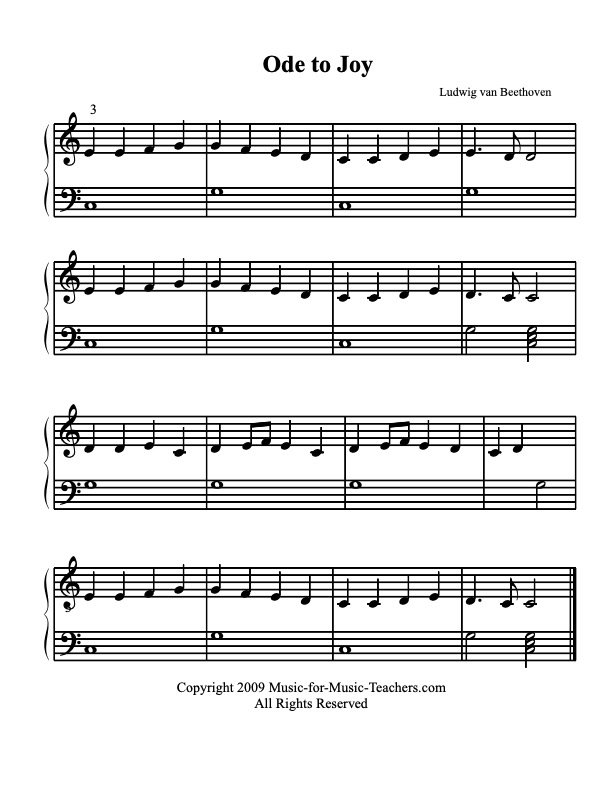#12 - How To Choose The Right Version?
FOR PARENTS OF BEGINNERS
Previously I’ve introduced the idea of letting your child choose their own song so they could feel a sense of excitement and connection to the piece they are playing. There are many educators and arrangers who create versions for the most popular songs, specifically in order to allow beginners to play the songs that they love. However, how do you choose the correct version for your child? This blog post will guide you how to discern between different versions so you can make sure you are choosing an appropriate version for your child.
We will use the often requested piece “Ode to Joy” by Ludwig van Beethoven, and explore three different versions of this piece. Just for observation, this piece was originally written as a part of Beethoven’s 9th Symphony for Orchestra and Choir, and is therefore very long. However, because this melody from it is so beloved and popular, different adaptations were created in order to allow musicians of all backgrounds to partake in the joy of playing this wonderful piece.
All versions used in this article were available for a free download by their creators. The arrangers will be credited, and the arrangements they wrote will be linked back to their origin in this article. This is the time to thank all these creators for making their educational materials available for public use!
Version 1
Let us begin with this version by North Carolina Symphony, the sheet music for which you will find below.
There are a great many notes in this arrangement – both right and left hands play two notes at a time. That is a lot to take in for someone who just learned how to read. Also notice that this arrangement includes a key signature (the two # signs before the 4/4), which is an indication to play specific notes as sharps or flats at all times. This is an additional piece of information that your child does not need at this stage. Finally, this arrangement is 24 measures long, which is a lot to a child to absorb. Accordingly, this version would not be the right place to begin.
© All rights reserved to North Carolina Symphony
Version 2
Moving on to the next one! This arrangement was written by “Music for Music Teachers”. You will also find this below.
We can already see how much more simplified this one is! It has far fewer notes, no key signature and only 16 measures. However, it still has multiple notes written in the left hand, as well as one sharp (#) sign. Not entirely non-doable, but if we can find a more simplified version, that would be preferable.
© All rights reserved to Music For Music Teachers
Version 3
Let’s explore the final one! This arrangement was also done by the fine people at “Music for Music Teachers”. You will find this below as well.
This version is also 16 measures long, but has far fewer notes written in the left hand, as well as no accidentals (sharps or flats). Furthermore, most of the notes look the same, which will be one less thing for the student to think about, and therefore likely lead to less confusion.
© All rights reserved to Music For Music Teachers
Conclusion
It looks like we have a winner! The third version is one that provides a wonderful practice for the student at a level that they can handle with pleasure.
And so, you were able to find a suitable version for a song that your child has asked for, which in turn will lead them to be more excited about their musical journey, feel more resilient and confident in tackling challenges, and give them much joy in playing a song that they love.
Advanced Practice
While this method proves itself to be very effective in most cases, it is of course not the right fit for every student. In my teachings, I have encountered quite a few students who felt invigorated and driven by playing from a book. For them, the experience of flipping a page and noticing their own progress by moving from page 12 to 16, for example, gives them the satisfaction they desire. Furthermore, there are some children who are not very used to the idea of choosing things for themselves, in which the book method could be helpful as well. I always tell these students: “if you happen to think of anything that you would really like to play, please tell me and we can move on to that if you’d like” – this tends to spark their interest and makes them think, and oftentimes come back with a song that they’d like to play.
So, you can always ask your child: “would you like to choose a song of your own, or play from a book?” – your child will know what is right for them and answer truthfully.
A FINAL THOUGHT
In my mind, the goal at this stage is to introduce your child to real-world music that they care about so that their experience won’t be so theoretical. Once this goal is achieved, it opens up the door to discovering new elements that are involved in piano playing little by little as they come along. Those would be fingering, accidentals, rests, key signatures, time signatures, rhythm and so on. All of these will be discussed in future blog posts, but the purpose of this post is to allow your child to play a version of their preferred song that would invigorate them and provide them with a pleasant platform to work on, over which all of these new pieces of information would be introduced one at a time.



